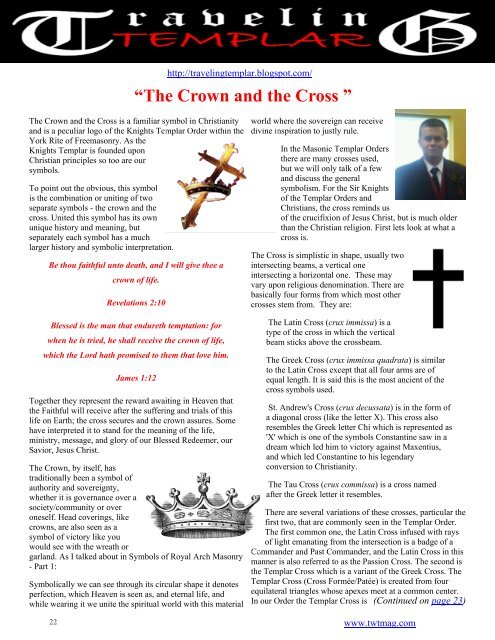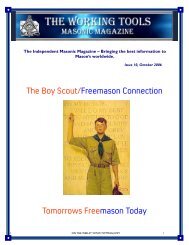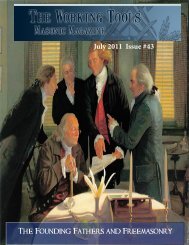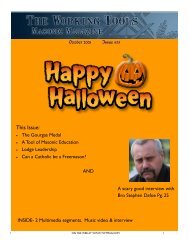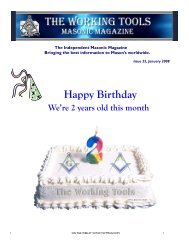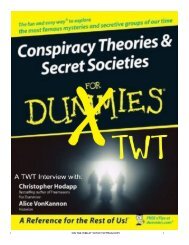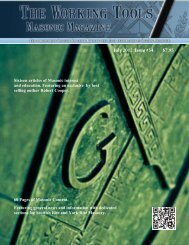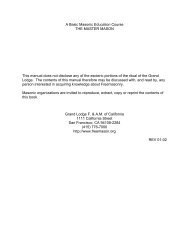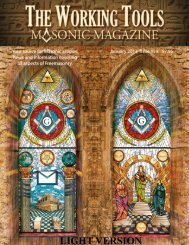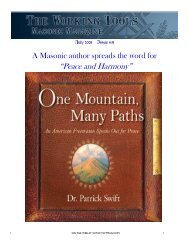The Working Tools Magazine âLightâ Version - Hawthorne-Fortitude ...
The Working Tools Magazine âLightâ Version - Hawthorne-Fortitude ...
The Working Tools Magazine âLightâ Version - Hawthorne-Fortitude ...
You also want an ePaper? Increase the reach of your titles
YUMPU automatically turns print PDFs into web optimized ePapers that Google loves.
http://travelingtemplar.blogspot.com/<br />
“<strong>The</strong> Crown and the Cross ”<br />
<strong>The</strong> Crown and the Cross is a familiar symbol in Christianity<br />
and is a peculiar logo of the Knights Templar Order within the<br />
York Rite of Freemasonry. As the<br />
Knights Templar is founded upon<br />
Christian principles so too are our<br />
symbols.<br />
To point out the obvious, this symbol<br />
is the combination or uniting of two<br />
separate symbols - the crown and the<br />
cross. United this symbol has its own<br />
unique history and meaning, but<br />
separately each symbol has a much<br />
larger history and symbolic interpretation.<br />
Be thou faithful unto death, and I will give thee a<br />
crown of life.<br />
Revelations 2:10<br />
Blessed is the man that endureth temptation: for<br />
when he is tried, he shall receive the crown of life,<br />
which the Lord hath promised to them that love him.<br />
James 1:12<br />
Together they represent the reward awaiting in Heaven that<br />
the Faithful will receive after the suffering and trials of this<br />
life on Earth; the cross secures and the crown assures. Some<br />
have interpreted it to stand for the meaning of the life,<br />
ministry, message, and glory of our Blessed Redeemer, our<br />
Savior, Jesus Christ.<br />
<strong>The</strong> Crown, by itself, has<br />
traditionally been a symbol of<br />
authority and sovereignty,<br />
whether it is governance over a<br />
society/community or over<br />
oneself. Head coverings, like<br />
crowns, are also seen as a<br />
symbol of victory like you<br />
would see with the wreath or<br />
garland. As I talked about in Symbols of Royal Arch Masonry<br />
- Part 1:<br />
Symbolically we can see through its circular shape it denotes<br />
perfection, which Heaven is seen as, and eternal life, and<br />
while wearing it we unite the spiritual world with this material<br />
world where the sovereign can receive<br />
divine inspiration to justly rule.<br />
In the Masonic Templar Orders<br />
there are many crosses used,<br />
but we will only talk of a few<br />
and discuss the general<br />
symbolism. For the Sir Knights<br />
of the Templar Orders and<br />
Christians, the cross reminds us<br />
of the crucifixion of Jesus Christ, but is much older<br />
than the Christian religion. First lets look at what a<br />
cross is.<br />
<strong>The</strong> Cross is simplistic in shape, usually two<br />
intersecting beams, a vertical one<br />
intersecting a horizontal one. <strong>The</strong>se may<br />
vary upon religious denomination. <strong>The</strong>re are<br />
basically four forms from which most other<br />
crosses stem from. <strong>The</strong>y are:<br />
<strong>The</strong> Latin Cross (crux immissa) is a<br />
type of the cross in which the vertical<br />
beam sticks above the crossbeam.<br />
<strong>The</strong> Greek Cross (crux immissa quadrata) is similar<br />
to the Latin Cross except that all four arms are of<br />
equal length. It is said this is the most ancient of the<br />
cross symbols used.<br />
St. Andrew's Cross (crux decussata) is in the form of<br />
a diagonal cross (like the letter X). This cross also<br />
resembles the Greek letter Chi which is represented as<br />
'X' which is one of the symbols Constantine saw in a<br />
dream which led him to victory against Maxentius,<br />
and which led Constantine to his legendary<br />
conversion to Christianity.<br />
<strong>The</strong> Tau Cross (crux commissa) is a cross named<br />
after the Greek letter it resembles.<br />
<strong>The</strong>re are several variations of these crosses, particular the<br />
first two, that are commonly seen in the Templar Order.<br />
<strong>The</strong> first common one, the Latin Cross infused with rays<br />
of light emanating from the intersection is a badge of a<br />
Commander and Past Commander, and the Latin Cross in this<br />
manner is also referred to as the Passion Cross. <strong>The</strong> second is<br />
the Templar Cross which is a variant of the Greek Cross. <strong>The</strong><br />
Templar Cross (Cross Formée/Patée) is created from four<br />
equilateral triangles whose apexes meet at a common center.<br />
In our Order the Templar Cross is (Continued on page 23)<br />
22 www.twtmag.com


